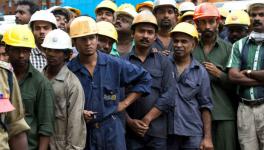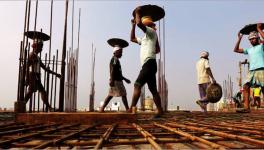Why Were 1.3 Crore Jobs Lost in June?

A perfect storm of delayed monsoon, languishing economy and continued inaction of the government on the jobs front has led to an astonishing decline of 1.3 crore from the total number of employed persons in the country in June this year, according to the latest CMIE estimates. In May, the number of employed persons were 40.4 crore which plummeted to just 39.1 crore by June end. As the chart below shows, employment has been hovering around the 40-crore mark for the past year, but the nose-dive last month has exposed the extreme vulnerability of India's working population.

An employment level of 39 crore means that only about 36% of the working-age population is actually employed in India. This tears apart the lofty talk of the advantages of ‘demographic dividend’ – a young working population – for India and reveals the dire and distressful situation of the Indian people.
Other measures of employment too have worsened. The labour participation rate (LPR) – the share of people who are working or willing and seeking to work – has also dropped from 39.91% in May to a low of 38.3% in June. This is the lowest LPR since the first lockdown back in April-May 2020. A reduced LPR means that hopeless and frustrated people have quit the labour force altogether, preferring to perhaps wait it out till jobs become available again.
Another measure of the job situation is the unemployment rate, which measures the share of the population that is actively seeking work. This has risen to 7.8% in June from 7.1% in May. The unemployment rate has been hovering around 7-8% for the past several months, generally indicating the chronic state of joblessness in the country.
IMMEDIATE CAUSES
The delayed onset of the monsoon in June this year is mainly responsible for the low number of employed and also the low labour participation rate. Usually, the sowing of Kharif crops, mainly paddy, starts in June with the arrival of monsoon rains. This is labour-intensivework with lakhs of agricultural labourers, including women, out in the fields transplanting paddy seedlings to coincide with the rains. However, the crucial monsoon rains were delayed this year, and rains began in a meaningful way only by the last week of June. The Indian Meteorological Department (IMD) estimated a mid-June deficit of over 32% in rainfall.
This meant that the army of agricultural labourers was forced into idleness through most of this month, causing a sharp increase in unemployment, a drop in LPR and a decline in the number of jobless. Agricultural labourers and small/marginal farmers are the most vulnerable section of Indian society and also the most numerous. The large-scale unemployment in these sections will not only cause huge distress among these poorest families but also implies that a substantial chunk of the population has no money in its hands. This will further depress the languishing demand and thus perpetuate the low level of economic activity that is haunting the economy.
It is probable that with the arrival of a full-fledged monsoon in most parts of the country by the end of June, joblessness will decline somewhat. But what this chain of events highlights is the extreme dependence of India on the monsoon and all the vulnerability that it brings. Even a delayed onset can mean a tremendous and large-scale impact on lakhs of families. This is not a sign of an advancing economy and definitely not a feature of an aspiring economic superpower.
CHRONIC JOBS CRISIS
CMIE estimates that the huge job losses in June include the loss of 25 lakh salaried jobs. This could not have much to do with the delayed onset of monsoon. It is the chronic or persistent aspect of India's economic crisis. With the industrial sector still growing very slowly or just stagnating, the biggest potential source of jobs has practically closed its doors to the displaced peasant and agricultural labourer. And, with demand stagnating, the industry has no prospects of increasing productive capacities and thus giving employment to new members of the workforce.
In fact, the Modi government is adopting policies that heighten the jobs crisis. It is trying to implement Labour Codes that will increase contractual work, with easy hire and fire, leading to more instability of employment. It is applying funds squeeze to various job-related schemes that provide some relief to jobless people. It has reduced the prospects of secure employment in the armed forces by announcing its partial contractualisation through the Agnipath scheme. Its reliance on the so-called 'new economy' jobs like startups and gig workers seem to be coming a cropper in recent times with large-scale job shedding. To assuage public sentiment, it announced that 10 lakh government vacancies will be filled up through the modus operandi of this filling up has not been announced, and in all probability, it will be through outsourced means, at low pay scales.
The prospects of any major jump in employment levels in the coming months are thus bleak, and with a stagnating economy which is also in the grips of an inflationary spiral, the distress of people is likely to mount.
Get the latest reports & analysis with people's perspective on Protests, movements & deep analytical videos, discussions of the current affairs in your Telegram app. Subscribe to NewsClick's Telegram channel & get Real-Time updates on stories, as they get published on our website.






















